User Manual
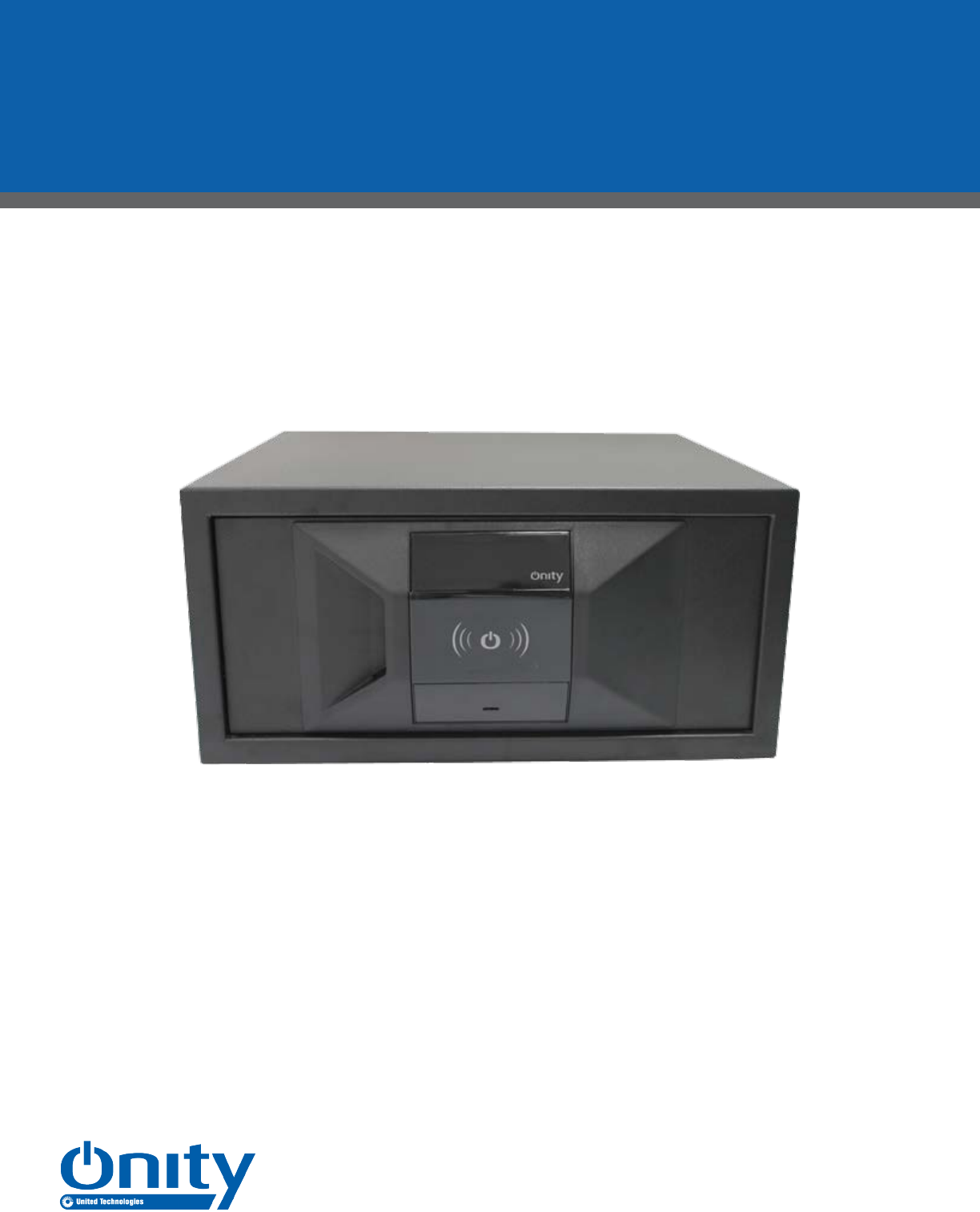
Onity OS700 RFID Safe
User Manual
Onity OS700 RFID Safe User Manual i
Table of Contents
1 Introduction .....................................................................................................................1
1.1 Features ........................................................................................................................................................... 1
1.2 Factory Mode .................................................................................................................................................. 1
1.3 Technical Support ........................................................................................................................................... 1
2 Guest Use ........................................................................................................................1
3 Emergency Opening .......................................................................................................2
4 Portable Programmer Operation ...................................................................................3
4.1 Initialization ..................................................................................................................................................... 3
4.2 Update .............................................................................................................................................................. 4
4.3 Test ................................................................................................................................................................... 4
4.4 Read Opening ................................................................................................................................................. 4
5 Maintenance ....................................................................................................................4
5.1 Test Battery Level ........................................................................................................................................... 4
5.2 Replace Batteries............................................................................................................................................ 4
5.3 Remove the Safe Door ................................................................................................................................... 5
5.4 Replace the Safe Door .................................................................................................................................... 5
6 CerticationsandLabel .................................................................................................6
7 Regulatory .......................................................................................................................6
8 Legal Disclaimer .............................................................................................................6
© 2018 Onity Inc. All rights reserved. Onity is a part of UTC Climate, Controls & Security, a unit of United Technologies Corporation. Microsoft, Outlook, Outlook Express, and Windows are either registered
trademarks or trademarks of Microsoft Incorporated in the United States and/or other countries. Netscape, Netscape Messenger, and Netscape Messenger are registered trademarks of the Netscape
Communications Corporation in the United States and other countries. Netscape’s logos and Netscape product and service names are also trademarks of Netscape Communications Corporation, which may
be registered in other countries. Other brand and product names are or may be the trademarks of, and are used to identify products or services of, their respective owners. The information in this document
is subject to change without notice. Onity assumes no responsibility for inaccuracies or omissions and specically disclaims any liabilities, losses, or risks, personal or otherwise, incurred as a consequence,
directly or indirectly, of the use or application of any of the contents of this document. 10106082P1 REV B EN
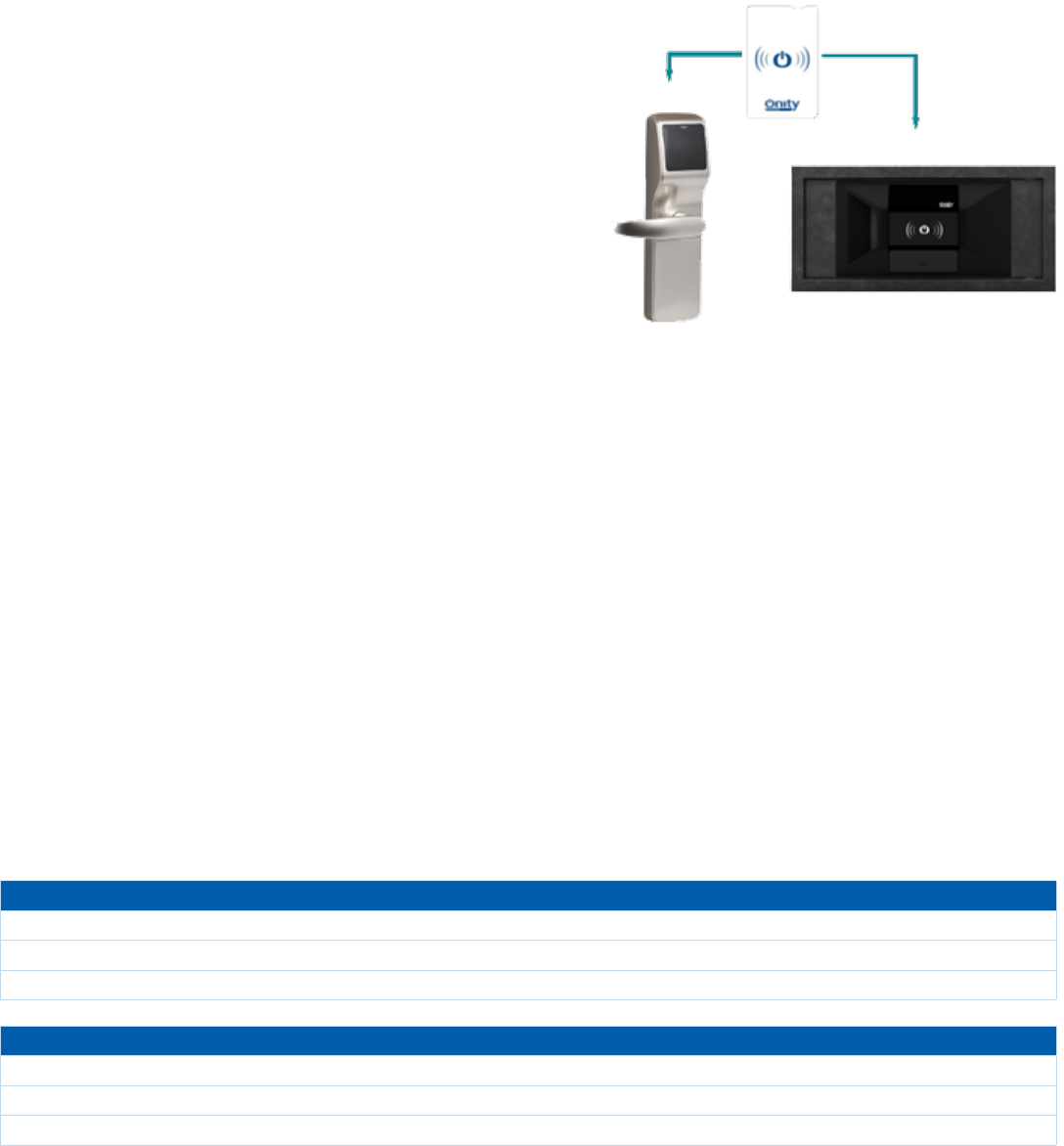
1
Onity OS700 RFID Safe User Manual
1 Introduction
The Onity OS700 RFID Safe User Manual describes how to use and maintain the OS700 RFID safe.
1.1 Features
• Powered by four (4) Alkaline batteries AA, providing
approximately 5000 cycles
• Audible feedback with different tones to indicate
valid or invalid cards, openings, and closings
• Integrates into Onity Systems (Onity® OnPortalTM
Lock Management system, HT24w, OnPoint and
HT22 stand-alone), using the key card to access
to the Onity front desk equipment, guest room, and
the OS700 safe
• Uses a Portable Programmer or tablet Portable
Programmer to open the safe
• Key override for emergency openings
• Has an audit trail feature which records the last 500
events in the auditor of the safe
1.2 Factory Mode
The OS700 RFID Safes are shipped unlocked and with some construction working cards included for their operation
(until the safes are initialized).
1.3 Technical Support
For technical support in North America, call 1-800-248-6189 or contact your sales representative. For technical support
in Europe/Middle East/Africa, call 34-943-448-300, email EMEA@onity.com or contact your sales representative.
2 Guest Use
When a guest arrives, the safe door should be opened. If the safe is locked when the guest arrives, it must be opened using
the Portable Programmer or with the safe master card.
If the OS700 safe door is closed and a new guest card is presented (not the previously used one) a red light and a sound
warning is displayed telling that the card is not valid.
During the stay, the guest can open and close the safe at any time. If a guest loses the card, they must report it to reception
to cancel the existing guest card. If the safe is closed they must contact reception to open it. The safe must be left unlocked
for the next guest.
Close the Safe
1. Place items in the safe and close the safe door.
2. Touch the key card to the safe RFID reader.
3. Green light ashes until the safe bolts are extended and the safe is closed.
Open the Safe
1. Touch the key card to the safe RFID reader.
2. Green light ashes until the safe bolts are retracted and the safe is open.
3. Open the safe door and remove items.
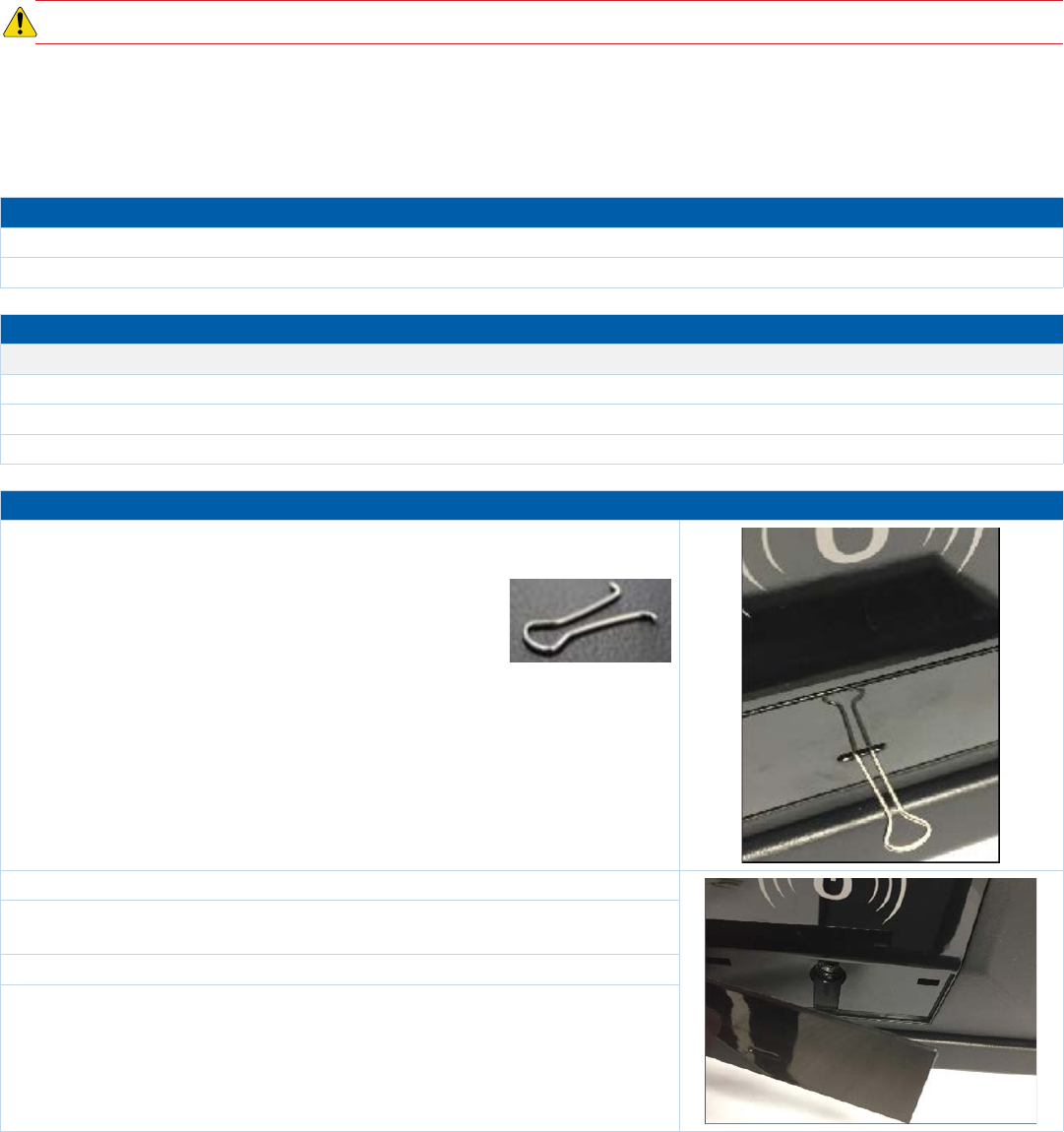
2
Onity OS700 RFID Safe User Manual
3 Emergency Opening
CAUTION! Keep all tools, emergency card, Portable Programmer, and mechanical key in a secure location.
There are three (3) ways to open the safe in emergency situations:
• Safe emergency card
• Portable Programmer or tablet PP
• Mechanical key
Safe Emergency Card Option
1. Touch the safe emergency key card to the safe RFID reader.
2. Green light ashes until the safe bolts are retracted and the safe is open.
Portable Programmer or Tablet PP Option
Note: The PP or Tablet PP would open the safe even if the safe batteries are dead.
1. Attach the PP cable to the safe RFID reader.
2. Use the OPEN option to open the safe.
3. Green light ashes until the safe bolts are retracted and the safe is open.
Mechanical Key Option
1. Insert the clip or screwdriver into the cover slot and remove the plas-
tic cover over the programming connection of the safe.
2. Insert the mechanical key in the cylinder hole.
3. Rotate the key clockwise until the bolts are retracted and the safe
door opens.
4. Retrieve your items.
5. Rotate the key counter-clockwise until the bolts secure the door.
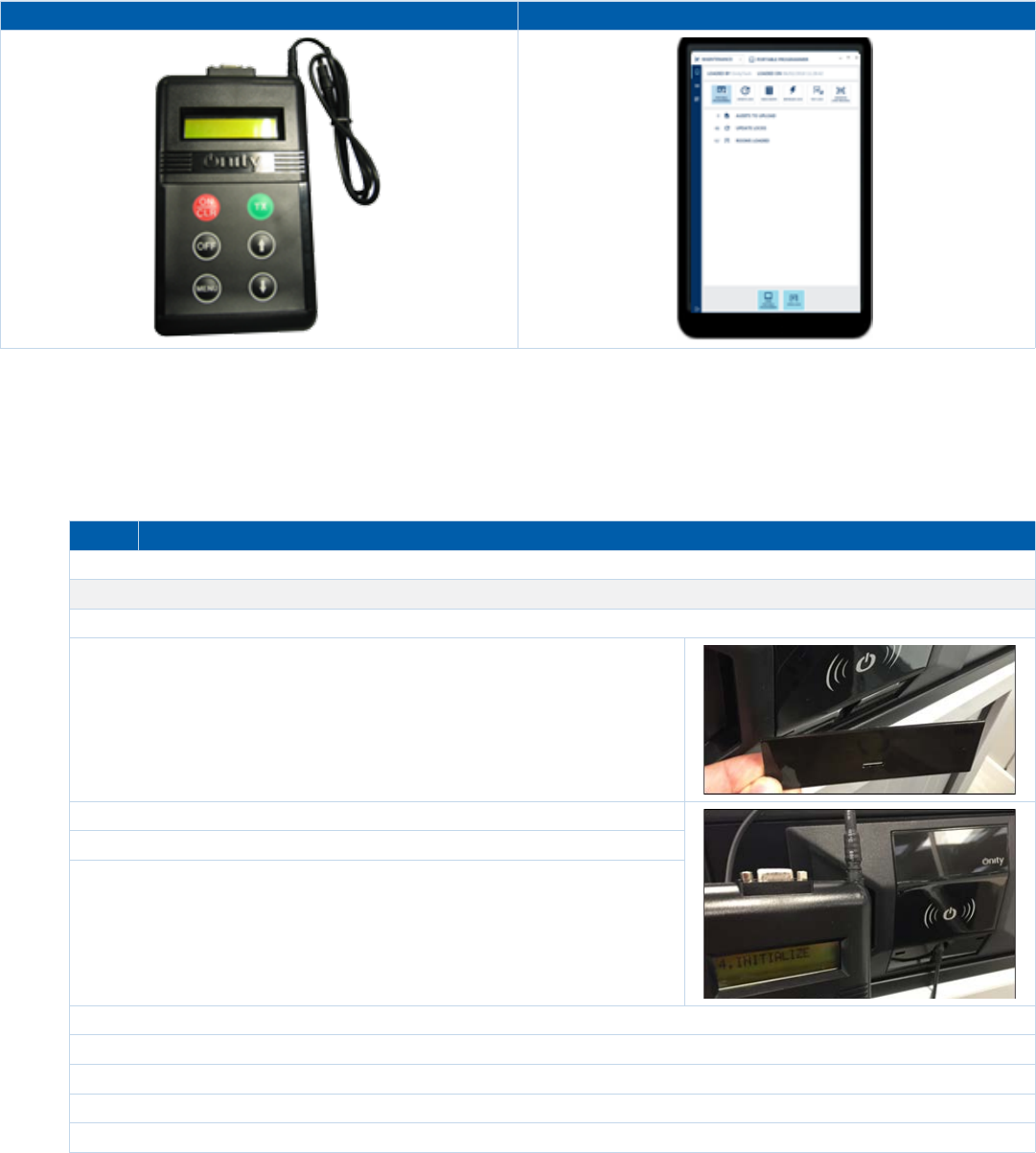
3
Onity OS700 RFID Safe User Manual
4 Portable Programmer Operation
The Portable Programmer (PP) model PP32, works with OS600 or OS700 Onity safes and Onity door locks. The PP can
open safes when the batteries are spent.
If OS700 safes are used with the HT24w, HT22, and OnPoint systems, it must be programmed through the PP. If the OS700
safes are used with the OnPortal system the PP or the tablet PP can be used. The safes must be added in the system
locking plan using one of the front desk Onity systems. Use the PP to test, perform maintenance, initialize, update, and
collect the audit data from the safes.
Portable Programmer Tablet Portable Programmer
4.1 Initialization
This option is used to establish the safe operation and provide a name to the safe. This is mostly used when
installing the OS700 safe the very rst time.
Note: The door must be open for the initialization.
Step Action
1. Load the data of the OS700 safes to the PP from the Onity front desk.
Note: The programming of the safe must be done with the door opened.
2. Open the OS700 safe with the construction card.
3. On the safe, remove the plastic plate that covers the PP connection
jack.
4. Connect the PP to the safe.
5. Turn ON the PP.
6. Using the arrow keys, select the menu option # 4. Initialize,
or select the Initialize Lock option on the screen.
7. Choose the safe to initialize by selecting the $ sign and room number (example: $101).
8. For the PP, press TX and for the tablet, tap Initialize Lock.
9. Disconnect the PP from the safe when nished.
10. Test the safe with a new guest card and the safe emergency card.
11. Align the plastic plate tabs with the tab slots and snap in position to replace the plate that was removed in step 3.

4
Onity OS700 RFID Safe User Manual
4.2 Update
This option is used when the safe conguration has changed and the new settings must be loaded into the safe.
The PP or tablet PP must be loaded with the latest information rst, then follow the steps in the Initialization process.
Common reasons to update safes:
• Twice a year if Daylight Saving Time applies
• Changes in special cards
• If the database (master users) or safe settings have been changed
4.3 Test
This option allows you to test and check some important points on the safes in order to see their status. Battery
level, rmware version, and more can be tested and displayed for a rst diagnosis of the safes.
4.4 Read Opening
This option collects all the audit data from the safe. The OS700 safe stores the last 500 events (openings and
closings).
In order to see the events, a standard PP must be connected to the Onity front desk system and the audit
data loaded into the system. After that, the events can be displayed in the PC screen, in the HT22 standalone
encoder, or in OnPoint system.
If a tablet PP is used, the audit data is displayed in the tablet or sent over LAN or WLAN to the Onity server.
5 Maintenance
If the safe door is closed and the batteries are dead, use the Portable Programmer to open the safe. Note: The safe door
will not close if the battery level is extremely low.
5.1 Test Battery Level
The battery level of the safe can be tested with a diagnostic card, master card, or using the Portable Programmer
(or tablet PP). Best Practice: Test the battery levels every six (6) months (minimum).
Step Action
1. Touch the safe diagnostic key card or master card to the safe RFID reader, or connect the PP.
2. If the green light ashes within three (3) seconds, the batteries levels are good.
3. If the green light is steady and the red light is ashing, go to the next section to replace the batteries.
5.2 Replace Batteries
WARNING! Use only fresh, approved, high-quality batteries with same type and rating. Never mix used and new
batteries in the safe. Battery holders with signs of corrosion must be replaced. Dispose of all batteries as required
by local ordinances, regulations, and/or the latest WEEE and European 2012/19/CE requirements. Do not throw
batteries in the common garbage.
Suggested batteries:
• Varta Industrial Alkaline 4006
• Energizer Industrial Alkaline 2010
• Panasonic Plus Alkaline
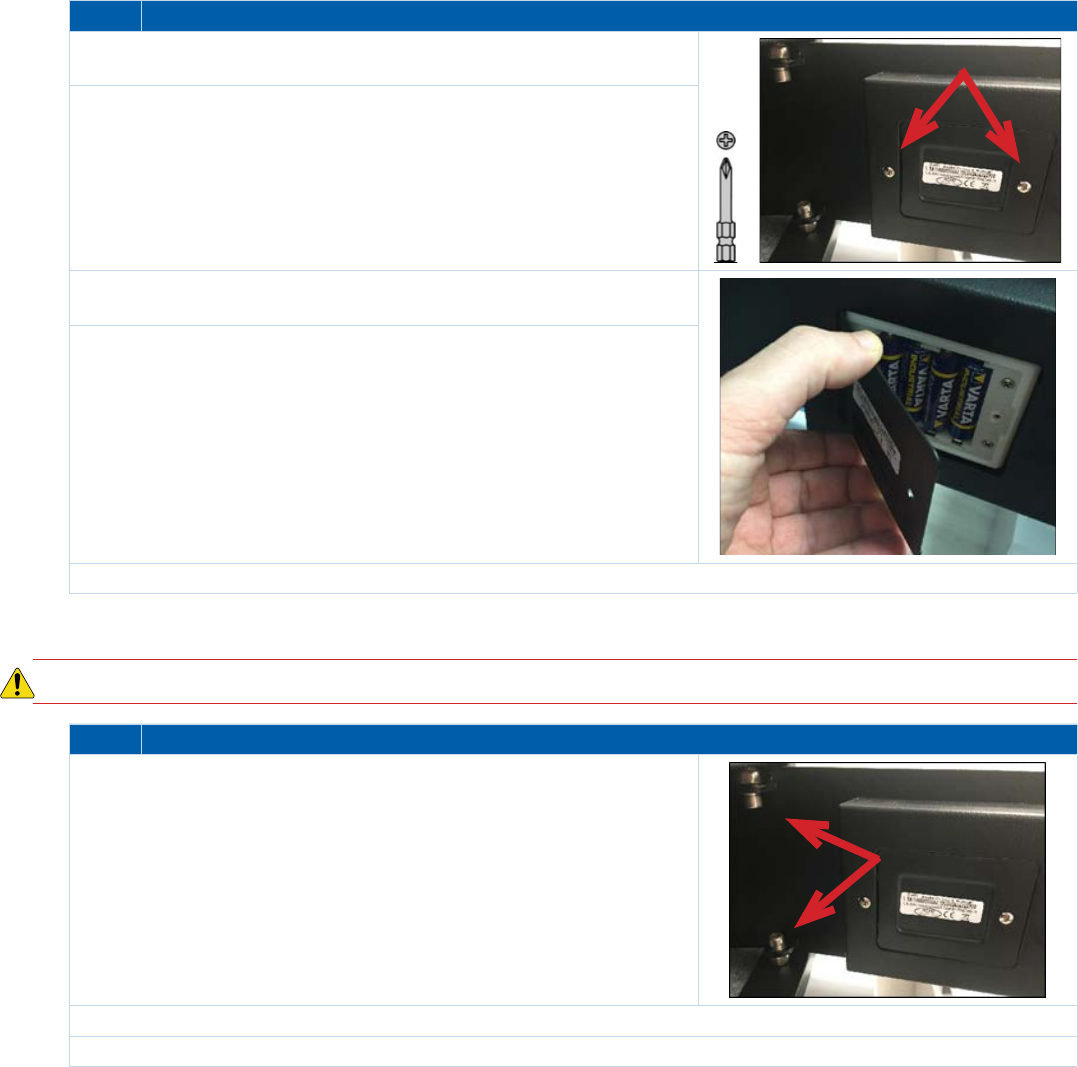
5
Onity OS700 RFID Safe User Manual
Step Action
1. Open the OS700 safe door and locate the battery cover at
the back of the door.
2. Using a Phillips screwdriver, unscrew the screws and remove
the battery cover.
3. Replace the batteries matching the correct polarity as shown
in battery holder.
4. Replace the battery cover and secure with screws.
5. Dispose of spent batteries per local regulations.
5.3 Remove the Safe Door
CAUTION! Be sure to hold on to the door during removal to keep it from falling. The door is very heavy.
Step Action
1. Using a 13mm ratchet, remove the two (2) nuts at the
hinged side of the door
2. After the two nuts are removed, partially close the door, and separate the hinge from the door.
3. Slide the door completely out of the slot between the hinge and the safe body.
5.4 Replace the Safe Door
To install the new door on all safes, reverse the steps used to remove it. Verify the door swings closed and opened.
When the door is properly aligned, replace the inside cover (if necessary) and secure it with the screws. With the
door open, present a valid RFID key card to make sure the bolts extend without obstruction from the inside cover.
If the bolts do not extend properly, adjust the inside cover accordingly.

6
Onity OS700 RFID Safe User Manual
6 CerticationsandLabel
Certications
• FCC, IC, & CE
• Radio Equipment Directive (2014/53/EU)
7 Regulatory
Regulatory Statements
United States
(FCC)
This device complies with part 15 of the FCC rules. Operation is subject to the following conditions:
1. This device may not cause harmful interference.
2. This device must accept any interference received, including interference that may cause undesired operation.
Changes or modications not expressly approved by the party responsible for compliance could void the user’s
authority to operate the equipment.
Canada (IC) This device complies with Industry Canada’s license-exempt RSSs. Operation is subject to the following two
conditions:
1. This device may not cause interference; and
2. This device must accept any interference, including interference that may cause undesired operation of
the device.
Cet équipement est conforme á Ia (aux) norme(s) canadienne(s) d’exemption de licence RSS Industry Canada.
Son opération est sujette aux deux conditions suivantes: (1) cet équipement ne provoquera aucune interference el
(2) cet équipement doit tolérer toute in interférence pouvant provoquer une opération indésirable de I’equipement.
European Union
(CE)
This Class B digital apparatus conforms to the requirements of the foIlowing EU directives:
1. Radio Equipment Directive (2014/53/EU)
2. WEEE Directive (2012/19/EC)
8 Legal Disclaimer
Use of the OS700 system and its documentation are governed by the terms set forth in your license. Such use is at your sole risk. The system
and its documentation (including this manual), are provided “AS IS” and without warranty of any kind and ONITY AND ITS LICENSORS EX-
PRESSLY DISCLAIM ALL WARRANTIES, EXPRESS OR IMPLIED, INCLUDING, BUT NOT LIMITED TO THE IMPLIED WARRANTIES OF
MERCHANTABILITY AND FITNESS FOR A PARTICULAR PURPOSE AND AGAINST INFRINGEMENT. ONITY DOES NOT WARRANT THAT
THE FUNCTIONS CONTAINED IN THE SYSTEM WILL MEET YOUR REQUIREMENTS, OR THAT THE OPERATION OF THE SYSTEM WILL
BE UNINTERRUPTED OR ERROR-FREE, OR THAT DEFECTS IN THE SYSTEM WILL BE CORRECTED. FURTHERMORE, ONITY DOES
NOT WARRANT OR MAKE ANY REPRESENTATIONS REGARDING THE USE OR THE RESULTS OF THE USE OF THE SYSTEM OR ITS
DOCUMENTATION IN TERMS OF THEIR CORRECTNESS, ACCURACY, RELIABILITY, OR OTHERWISE. NO ORAL OR WRITTEN INFOR-
MATION OR ADVICE GIVEN BY ONITY OR AN ONITY AUTHORIZED REPRESENTATIVE SHALL CREATE A WARRANTY OR IN ANY WAY
INCREASE THE SCOPE OF THIS WARRANTY. SOME JURISDICTIONS DO NOT ALLOW THE EXCLUSION OF IMPLIED WAR¬RANTIES, SO
THE ABOVE EXCLUSION MAY NOT APPLY.
UNDER NO CIRCUMSTANCES INCLUDING NEGLIGENCE, SHALL ONITY, ITS LICENSORS OR THEIR DIRECTORS, OFFICERS, EMPLOY-
EES OR AGENTS BE LIABLE FOR ANY INCIDENTAL, SPECIAL OR CONSEQUENTIAL DAMAGES (INCLUDING DAMAGES FOR LOSS OF
BUSINESS, LOSS OF PROFITS, BUSINESS INTERRUPTION, LOSS OF BUSINESS INFORMATION AND THE LIKE) ARISING OUT OF THE
USE OR INABILITY TO USE THE SYSTEM OR ITS DOCUMENTATION, EVEN IF ONITY OR AN ONITY AUTHORIZED REPRESENTATIVE
HAS BEEN ADVISED OF THE POSSIBILITY OF SUCH DAMAGES. SOME JURISDICTIONS DO NOT ALLOW THE LIMITATION OR EXCLU-
SION OF LIABILITY FOR INCIDENTAL OR CONSEQUENTIAL DAMAGES SO THE ABOVE LIMITATION OR EXCLUSION MAY NOT APPLY.
In no event shall Onity’s total liability to you for all damages, losses, and causes of action (whether in contract, tort, including negligence, or oth-
erwise) exceed the amount paid for the system and its documentation.